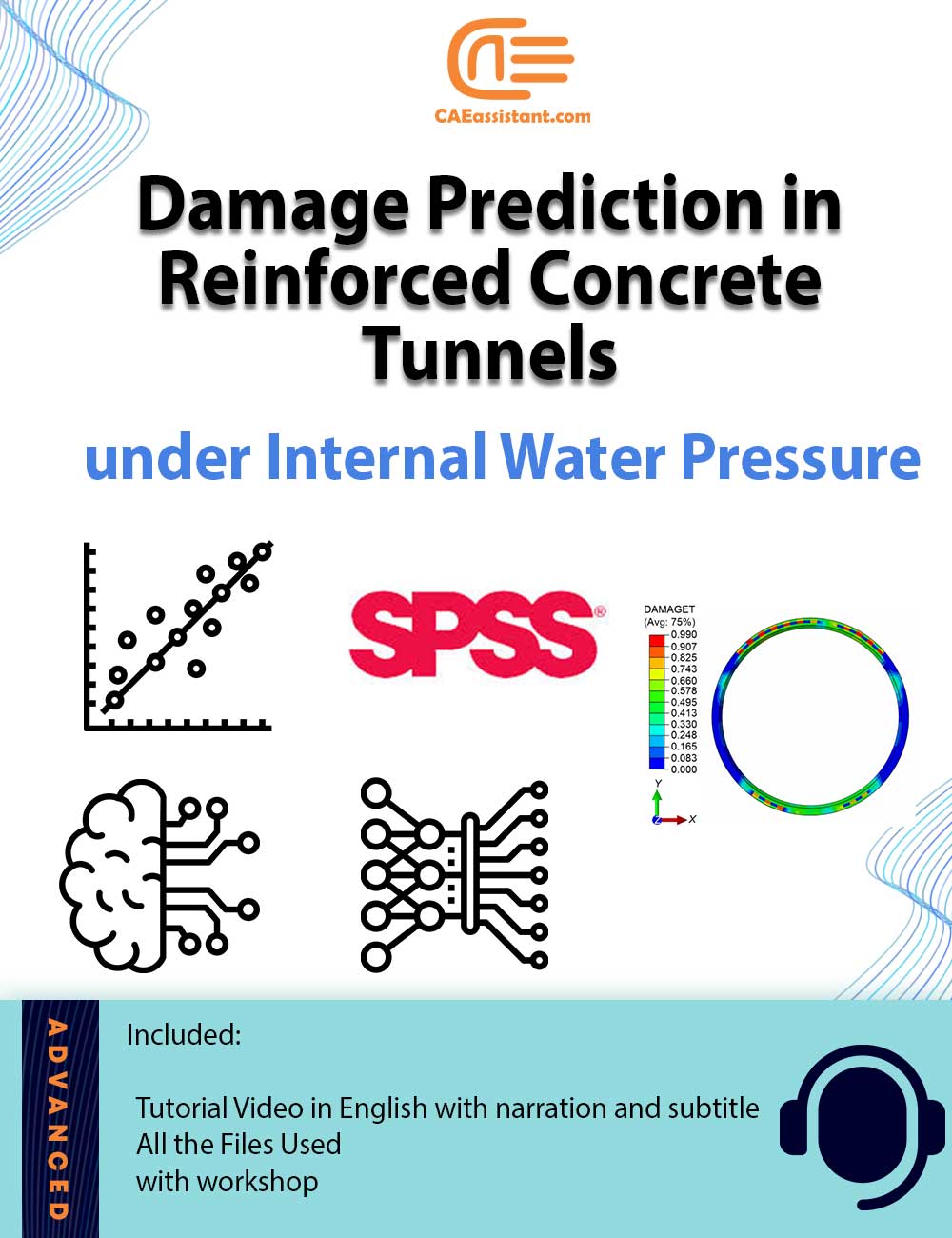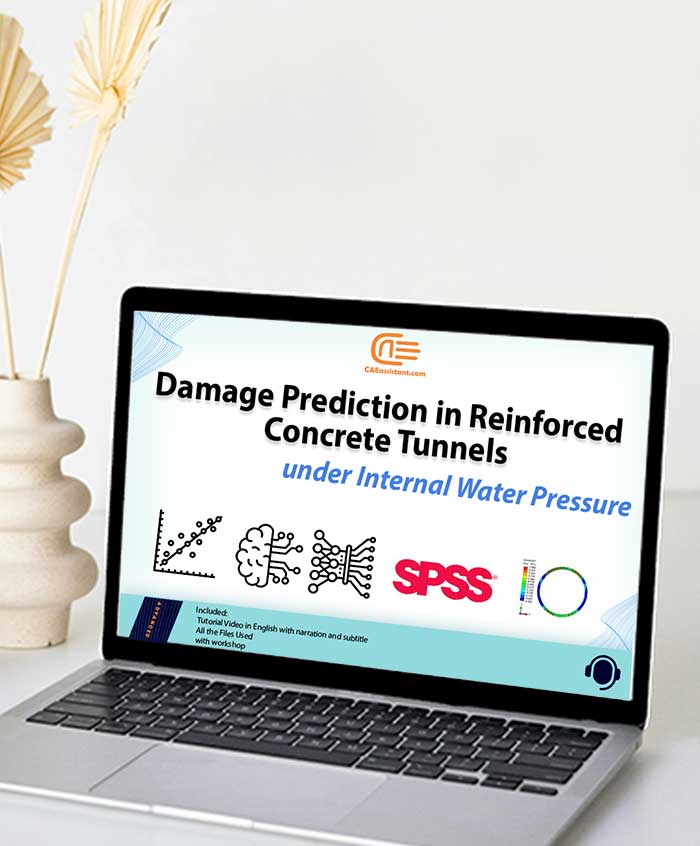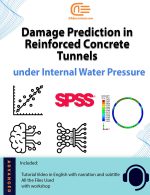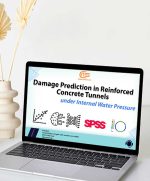Introduction
Damage prediction for the existing structures is one of the essential analyses because by regular damage detection and protection for the existing structures, capital costs, as well as repair and maintenance costs, can be saved. Damage detection requires an accurate simulation to specify the damaged zone based on various factors and reasons. In addition, the simulation of reinforced concrete tunnels under internal water pressure to predict the damaged zone requires a complex simulation using the FE model. These types of simulations need a strong system and a long time for simulation and analysis; thus, the cost and time of analysis are increased. For this issue, some with-box and black-box models, like regression models, Gene Expression Programming (GEP), Machine Learning (ML) methods, Deep Learning (DL) methods, hybrid models, and ensemble models, can be used to save time and cost of calculation. In addition, by these prediction models, in a second, the effect of changing a parameter or more parameters on the response of the structure can be estimated with a high accuracy. Furthermore, by employing the prediction models, the results of the analyses can be used for many designs, and the optimized design can be estimated. This project will utilize three distinct methods, each of which will be the subject of a separate workshop.
What is the structural behavior of reinforced concrete tunnels under internal water pressure?
A dam and its hydraulic structure are among the most important requirements for humans to save water in the reservoir and produce electricity. The loading and pressure in these structures are due to hydric phenomena, like cavitation, for the hydraulic-reinforced concrete tunnel. Simulation of the internal water pressure needs hydraulic analysis using the finite volume method (FVM), which is a complex and long analysis. The pressure of the hydraulic phenomena can be converted to mechanical pressure. This pressure causes tearing of the concrete surface and damage to the surface and thickness of the RCT.
The performance of RCT under internal water pressure is evaluated by using nonlinear Finite Element Analysis (FEA) and surrogate models. Several parameters, including the compressive and tensile strength of concrete, the size of the longitudinal reinforcement bar, the transverse bar diameter, and the internal water pressure, are considered as input variables. Based on the levels of variables, 36 mix designs are selected by the Taguchi method, and 12 mix designs are proposed. Also, Carbon fiber reinforced concrete (CFRC) or Glass fiber reinforced concrete (GFRC) is considered for simulating these 12 samples. After the validation of the FEA model, these 48 samples are simulated using the validated FEA model. The percentage of the damaged surfaces, the maximum effective tensile plastic strain (ETPS), The deflection of tunnel crown (m), and The maximum deflection of tunnel (m) are considered as the variables to evaluate the damage on the surface and thickness of the RCT.
Why a parametric study should be done for this target?
There is no specific standard, equation, reference book, or design book for the simulation of the RCT under internal water pressure. As a result, the simulation of RCT under internal water pressure needs a complex analysis, and the time and cost of simulation are significant. There are many design parameters that have an effect on the performance of RCT under internal water pressure; therefore, several samples should be simulated with various design parameters to specify the effect of the design parameters on the sample behavior, although using a design method, like Taguchi, the number of samples can be decreased.
How many samples should be simulated?
The number of samples is related to the number of design parameters and their levels that should be changed in the study. The levels can be specified according to requirements, reality, and standards. For example, the required sample numbers for a parametric study with four five variables and three levels for each variable should be at least 243 samples. The design parameters include the dimensions of structural elements, strength of steel and concrete, ratio of steel reinforcement bars, and internal water pressure.
Simulation of the sample by FEA using ABAQUS
In order to simulate RCT under internal water pressure, RCT is simulated under equivalent internal water pressure. After developing the validated FEA model, the samples, which are specified in the last section, should be simulated and analyzed. Von Mises is used in the simulation of the samples. Von Mises stress is a value used to determine if a given material will yield or fracture. It is mostly used for ductile materials, such as metals. The von Mises yield criterion states that if the von Mises stress of a material under load is equal to or greater than the yield limit of the same material under simple tension, then the material will yield. Overall, 48 samples for the evaluation of the behavior of ECT under internal water pressure were simulated and analyzed by ABAQUS.
Simulation of the FEA results using the AI method
The FEA dataset includes training datasets and testing datasets that should be specified randomly. After training the models using the training datasets, the models should predict the behavior of RCT under internal water pressure. The principal component regression (PCR), Multi Ln equation regression (MLnER), and gene expression programming (GEP) are employed for predicting the percentage of damaged surfaces (PDS) of the RCT, the effective tensile plastic strain (ETPS), the maximum deflection of the RCT, and the deflection of the crown of RCT. All models can be compared based on the time and cost of calculation and accuracy. However, the accuracy of models is compared by the statistical parameters and error terms that include the coefficient of determination, root mean square error (RMSE), normalized square error (NMSE), fractional bias, maximum positive error, maximum negative error, distribution of errors, and mean absolute error. MATLAB is used for this part.
Method 1: Using SPSS to generate the samples with various parameters
The samples and the variation in design parameters should be logical and based on the standards and reality. To optimize the number of samples for simulation, the Taguchi approach will be used by SPSS.
Method 2: Using ABAQUS to validate a FEA model and simulation of all models
ABAQUS is used to validate an FEA model. In order to validate a FEA model, a sensitivity analysis should be conducted. After that, using the validated FEA model, the behavior of samples under internal water pressure is simulated.
Method 3: Using ABAQUS to validate a FEA model and simulation of all models
MATLAB is used to develop AI methods, including regression methods, GEP, ANFIS, and ensemble methods. The statistical parameters and error terms are calculated by one of these software.
Workshop 1: Design a parametric study and optimize the number of samples in the parametric study
In this workshop, first, the effective factors in designing the samples for a parametric study are presented. An appropriate parametric study should consider all effective variables; thus, specifying the effective variables for each parametric study is important. Although by increasing the number of samples, the accuracy of analysis will be increased, the time and cost of the analysis will be increased; therefore, in the second part of this workshop, Taguchi as a method for designing a parametric study is explained to optimize the number of samples, although it keeps the accuracy of analysis for a big data.
Workshop 2: FEA modeling of RCT under internal water pressure and validation
In this Workshop, the simulation of RCT under water pressure is explained step by step in ABAQUS software, and after that, four samples that refer four experimental studies, are simulated by ABAQUS. The validation of FEA model is very important for each FEA model. Therefore, in the end, the validation of the FEA model using mesh sensitivity analysis and comparing the results of FEA with experimental results is presented.
Workshop 3: Simulation of the RCT under internal water pressure by prediction methods
Using regression models, GEP, Machine Learning (ML), hybrid models, and ensemble models, the behavior of RCT under internal water pressure is predicted. For using these methods, the dataset, which is the collection of design parameters, loading conditions, and the behavior of RCT under internal water pressure, is separated randomly into two groups, including training and testing datasets. The training dataset is used to train the prediction models, and after that, the models are used to predict the response of the RCT under internal water pressure based on design parameters. The statistical parameters and error terms are used to compare the model in this Workshop.





Reviews
Clear filtersThere are no reviews yet.